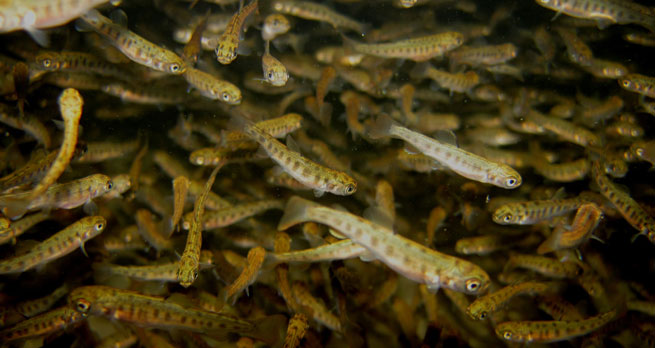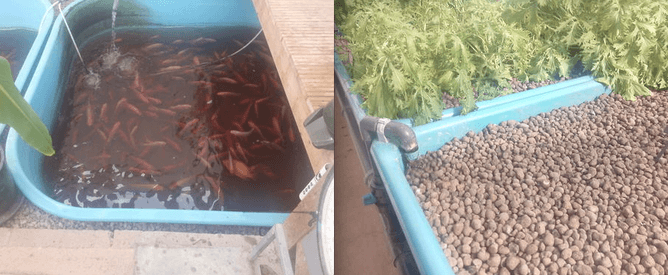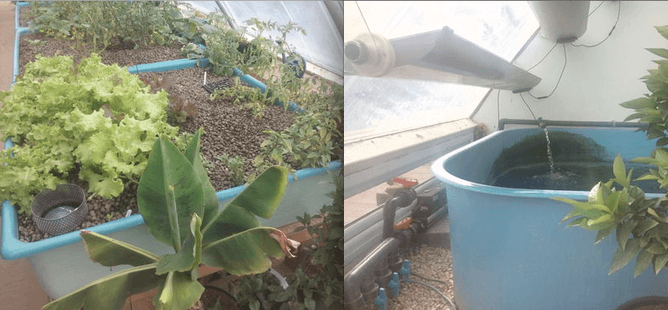Who needs soil when you have a fish tank? “Aquaponics” combines growing plants in water, or hydroponics, with fish cultivation, or aquaculture. It’s a symbiotic process that has its roots in Asian farming practices reaching back thousands of years. When used well, aquaponics can increase local food production and make communities more resilient – all without creating pollution or using scarce resources, such as oil.
 These trout fry could help provide the fertilizer to make chips...
These trout fry could help provide the fertilizer to make chips...
It begins with fish poo and pee, both of which contain lots of ammonia. Worms that live in rooting substrates break the solids down and then bacteria convert the ammonia into nitrate, which acts as a fertiliser. The plants absorb the nitrate and effectively filter the water for the fish. By which point the fish will once again need the toilet, and so on. It’s a virtuous circle.
The result is high-density food production that works equally well at home or in large industrial warehouses. It’s suitable in urban spaces or on land suffering from drought, pollution or soil depletion that is otherwise difficult to farm. It produces both fish and vegetables, reducing the load on our over-exploited and polluted oceans.
Year-round growing is possible (for indoor systems), and the system is even more water efficient than hydroponics, producing two products using the same water. Fish food is the only major input required, and it’s easier to use bio-controls against pests compared to soil-based agriculture.
Fun at the farm
BBC presenter Kate Humble now runs the Humble by Nature teaching farm on a hill above the Wye valley in Wales. Her team have built a solar greenhouse with three large tanks of tilapia (a hardy, fast-growing fish) and 12 growbeds full of vibrant crops. One of us – Hamish – visited recently.
 Water goes from fish tanks to growbeds... and back again
Water goes from fish tanks to growbeds... and back again
Water is pumped constantly from the tanks into the growbeds, which each contain a clever gizmo called an autosiphon, which drains the bed as soon as it fills right to the top. The plant roots, and the worms and bacteria living under them, live in a continual flood-drain environment, which is very conducive to rapid growth (as demonstrated in various hydroponics systems).
The plants soak up the fish waste, and the clean water is pumped back into the fish tanks:
 Once the plants have soaked up all the nutrients in the water, it%u2019s sent back to the fish. The autosiphon is front left
Once the plants have soaked up all the nutrients in the water, it%u2019s sent back to the fish. The autosiphon is front left
The technology is necessarily bio-organic: adding fertilisers or pesticides to the growbeds would soon damage the fish, while feeding the fish antibiotics would harm the plants. In any case, there is less need for agrochemicals and pharmaceuticals since aquaponics means less disease and faster growth<.
The widespread use of agrochemicals in our current food production makes us less resilient. Most food production is dependent on oil and thus vulnerable to volatile prices, and many inject toxicity into our environment and compromise long-term sustainability.
What’s the catch?
Aquaponics relies on a continuously balanced ecosystem of fish, veg, bacteria and (sometimes) worms. Sustaining this balance can be complex. Setup costs and energy usage are also an issue, varying according to climate and species of fish (from trout to sturgeon, tilapia to catfish – all have different requirements).
Together with colleagues we’re working with recycled materials to bring down costs of construction, and setting up measurement experiments so that we can say exactly what it costs to grow different types of crops in a Sheffield or a London climate, for example.
We’re also developing free, open source monitoring and control systems for aquaponics. These aggregate data via the cloud to create virtual communities of growers whose shared experience makes it easier for everyone.
But there’s still lots more to find out. We’re both part of an EU Aquaponics Hub that will try to better understand how fish and veg can work together, and will facilitate innovative ways to produce high-density, high quality and more sustainable food locally.
We currently rely on shipping large amounts of food across the world, leaving us remarkably vulnerable to disruption from wars, climate chaos, or volatile oil prices. Growing as much food as possible locally could boost resilience and allow us to start taking more control of what we eat, and reduce the intake of salt, sugar and preservatives, which drive diabetes and heart disease. Aquaponics is a sustainable and intensive alternative to both growing in soil and to hydroponics.![]()
This article was originally published on The Conversation. Read the original article.
Rate and Review
Rate this article
Review this article
Log into OpenLearn to leave reviews and join in the conversation.
Article reviews